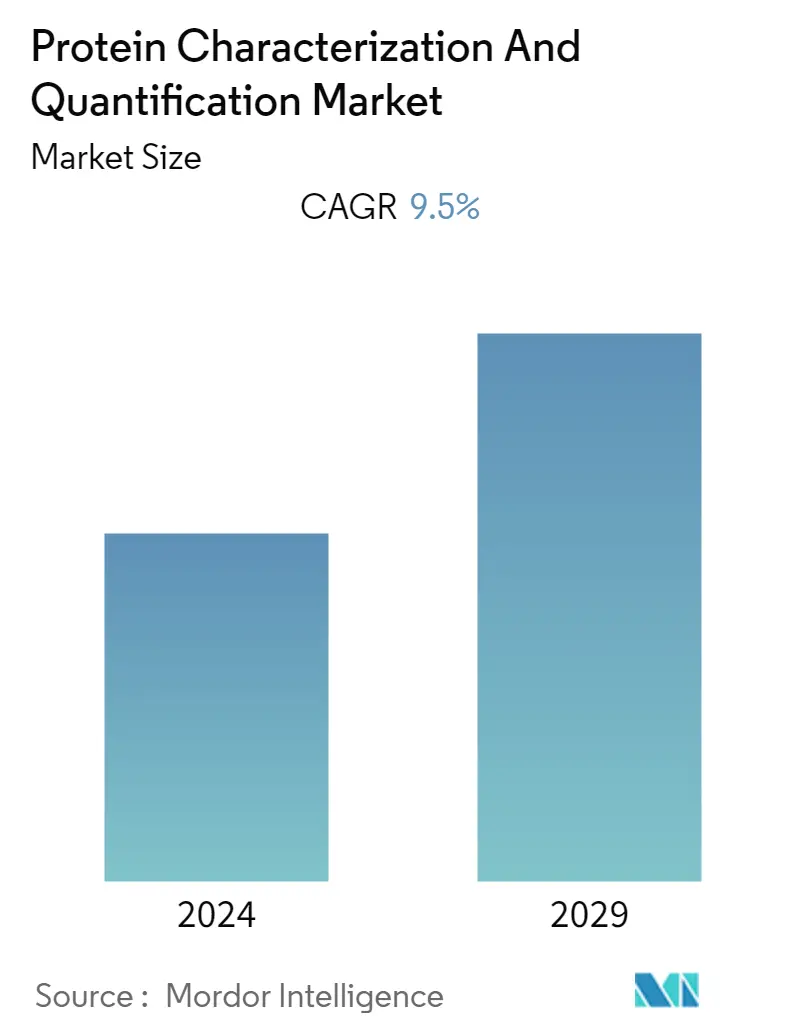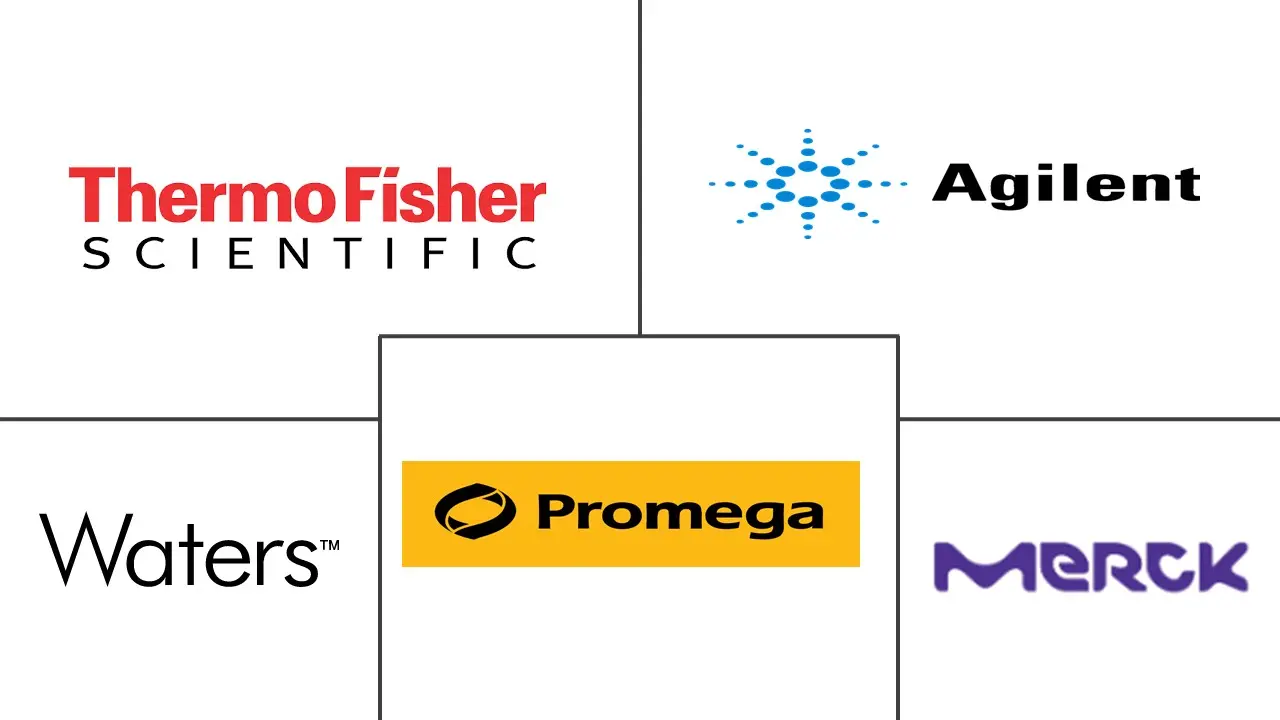Market Size of Protein Characterization And Quantification Industry

| Study Period | 2021 - 2029 |
| Base Year For Estimation | 2023 |
| CAGR | 9.50 % |
| Fastest Growing Market | North America |
| Largest Market | Asia-Pacific |
| Market Concentration | Medium |
Major Players
*Disclaimer: Major Players sorted in no particular order |
Protein Characterization And Quantification Market Analysis
The Protein Characterization and Quantification Market is expected to register a CAGR of 9.5% over the forecast period.
The market was initially slightly impacted due to the COVID-19 pandemic, with elevated research on the protein involved in the SARS-CoV-2 infection process and progression of COVID-19, which increased the market growth. For instance, a study published in the Journal of Virological Methods in May 2022 highlighted using targeted mass spectrometry of a virus-based vaccine to quantify the SARS-CoV-2 spike antigen. The study demonstrated that the mass spectrometric (MS) spike protein quantification method can quantify antigens within a sample such as a vaccine or therapeutic sample. Thus, the demand for protein quantification and characterization increases in such instances, significantly impacting the studied market. However, from late 2021, the number of COVID-19 cases decreased due to the mass vaccinations and wide availability of the vaccine and diagnosis. It enabled the market to grow normally, with the resumption of research studies and diagnosis of other chronic diseases and infections. Thus, the COVID-19 outbreak positively impacted the market's growth in its preliminary phase. Moreover, the market is expected to grow at a stable pace with increasing research, characterization, and protein quantification in various chronic diseases.
Further, the protein characterization and quantification market is expected to grow further with biologics' increasing adoption, increasing R&D expenditure and government funding for proteomics, and technological advancements to contribute to market growth. For instance, according to the article published in Advanced Drug Delivery Reviews in March 2021, current therapies do not adequately address the multiple dysregulated systems following Myocardial Infarction. Hence, recent studies developed novel biologics delivery systems to address these diseases. The demand for biologics is also on the rise, driving the key developments of the market players in developing and offering more biologics. For instance, in September 2021, Biocon Biologics Limited (BBL), a subsidiary of Biocon Ltd., signed an agreement with Serum Institute Life Sciences Private Limited (SILS), a subsidiary of Serum Institute of India Pvt. Ltd. Under the agreement, BBL offered its 15% stake to SILS, which would elevate the production of COVID-19 vaccines at SILS's facility in Pune, India.
Further, in March, Eisai Co., Ltd. received acceptance from the United States Food and Drug Administration (FDA) for Eisai's supplemental Biologics License Application (sBLA) for LEQEMBI (lecanemab-irmb) injection. The therapeutic biologic is a humanized immunoglobulin gamma 1 (IgG1) monoclonal antibody to treat Alzheimer's Disease. Also, in May 2022, Prellis Biologics, Inc. signed a collaboration and license option agreement with Sanofi SA. Under the agreement, both companies would focus on generating human antibodies for targeted diseases. The research to develop drug delivery systems for biologics is expected to increase over the forecast period, positively impacting the market's growth.
Furthermore, governments and private bodies are promoting research in proteomics and protein studies by raising funds. As a result, the protein detection and quantification market is expected to grow significantly in the coming years. For instance, Novo Holdings invested over USD 40 million in a proteomics technology company, Evosep. The investment would expand the global geographical presence and proteomics portfolio. Further, in August 2021, the Minister of Innovation, Science and Industry of Canada invested over CAD 144.47 thousand (USD 107.02 thousand) to support the project 'Predict to Prevent: Advanced Proteomics Profiling for Precision Medicine' at the Université Laval, Canada. Thus, rising research and development investments are likely to boost the research activity for protein characterization and quantification, thereby boosting the market studied.
Therefore, owing to the above factors, including the rising research investments and the increasing adoption of biologics, the studied market is anticipated to grow over the analysis period. However, the high cost associated with instrumentation will likely impede market growth.
Protein Characterization And Quantification Industry Segmentation
As per the scope of the report, protein characterization involves using experimental methods that allow for the detection and isolation of a protein and its purification, as well as the characterization of its structure and function. On the other hand, protein quantification is required to determine the total protein content of a sample or a formulated product. The Protein Characterization and Quantification Market is segmented by product and services (consumables, instruments (mass spectrometry instruments, chromatography instruments, electrophoresis instruments, label-free detection instruments, spectroscopy instruments, and other instruments), and services), application (drug discovery and development, clinical diagnosis, and other applications), end-user (pharmaceutical and biotechnology companies, contract research organizations, and other end users), and geography (North America, Europe, Asia-Pacific, Middle East and Africa, and South America). The report also covers the estimated market sizes and trends for 17 countries across major global regions. The report offers the value (USD) for the above segments.
| Product and Services | ||||||||
| Consumables | ||||||||
| ||||||||
| Services |
| Application | |
| Drug Discovery & Development | |
| Clinical Diagnosis | |
| Other Applications |
| End User | |
| Biotechnology & Pharmaceutical Companies | |
| Contract Research Organization | |
| Other End Users |
| Geography | ||||||||
| ||||||||
| ||||||||
| ||||||||
| ||||||||
|
Protein Characterization And Quantification Market Size Summary
The protein characterization and quantification market is poised for substantial growth, driven by increasing research and development activities, the rising adoption of biologics, and advancements in proteomics technology. The market experienced an initial boost due to the COVID-19 pandemic, which spurred research into protein interactions with the virus, thereby enhancing the demand for protein quantification methods. As the pandemic's impact waned, the market returned to a steady growth trajectory, supported by ongoing research into chronic diseases and infections. The market's expansion is further fueled by government and private sector investments in proteomics, as well as technological advancements that facilitate more efficient protein characterization and quantification processes.
North America is expected to be a significant growth region, attributed to its high prevalence of chronic diseases, substantial research and development expenditure, and active market players. The demand for protein characterization and quantification is particularly strong in the context of cancer research and the development of gene and monoclonal antibody-based therapies. Key developments by market players, such as new product launches and strategic collaborations, are also contributing to the market's growth. Despite the promising outlook, the market faces challenges, including the high costs associated with advanced instrumentation. Nonetheless, the ongoing advancements in mass spectrometry and other technologies are anticipated to drive the market forward, with leading companies like Thermo Fisher Scientific, Agilent Technologies, and Merck KGaA playing pivotal roles in shaping the industry's future.
Protein Characterization And Quantification Market Size - Table of Contents
-
1. MARKET DYNAMICS
-
1.1 Market Overview
-
1.2 Market Drivers
-
1.2.1 Increasing Adoption of Biologics
-
1.2.2 Increasing R&D Expenditure and Government Funding for Proteomics
-
1.2.3 Technological Advancements in Protein Characterization and Quantitation
-
-
1.3 Market Restraints
-
1.3.1 High Cost Associated with Instrumentation
-
-
1.4 Porter's Five Forces Analysis
-
1.4.1 Bargaining Power of Suppliers
-
1.4.2 Bargaining Power of Buyers/Consumers
-
1.4.3 Threat of New Entrants
-
1.4.4 Threat of Substitute Products
-
1.4.5 Intensity of Competitive Rivalry
-
-
-
2. MARKET SEGMENTATION (Market Size by Value - USD)
-
2.1 Product and Services
-
2.1.1 Consumables
-
2.1.2 Instruments
-
2.1.2.1 Mass Spectrometry Instruments
-
2.1.2.2 Chromatography Instruments
-
2.1.2.3 Electrophoresis Instruments
-
2.1.2.4 Label-free Detection Instruments
-
2.1.2.5 Spectroscopy Instruments
-
2.1.2.6 Other Instruments
-
-
2.1.3 Services
-
-
2.2 Application
-
2.2.1 Drug Discovery & Development
-
2.2.2 Clinical Diagnosis
-
2.2.3 Other Applications
-
-
2.3 End User
-
2.3.1 Biotechnology & Pharmaceutical Companies
-
2.3.2 Contract Research Organization
-
2.3.3 Other End Users
-
-
2.4 Geography
-
2.4.1 North America
-
2.4.1.1 United States
-
2.4.1.2 Canada
-
2.4.1.3 Mexico
-
-
2.4.2 Europe
-
2.4.2.1 Germany
-
2.4.2.2 United Kingdom
-
2.4.2.3 France
-
2.4.2.4 Italy
-
2.4.2.5 Spain
-
2.4.2.6 Rest of Europe
-
-
2.4.3 Asia-Pacific
-
2.4.3.1 China
-
2.4.3.2 Japan
-
2.4.3.3 India
-
2.4.3.4 Australia
-
2.4.3.5 South Korea
-
2.4.3.6 Rest of Asia-Pacific
-
-
2.4.4 Middle East and Africa
-
2.4.4.1 GCC
-
2.4.4.2 South Africa
-
2.4.4.3 Rest of Middle East and Africa
-
-
2.4.5 South America
-
2.4.5.1 Brazil
-
2.4.5.2 Argentina
-
2.4.5.3 Rest of South America
-
-
-
Protein Characterization And Quantification Market Size FAQs
What is the current Global Protein Characterization and Quantification Market size?
The Global Protein Characterization and Quantification Market is projected to register a CAGR of 9.5% during the forecast period (2024-2029)
Who are the key players in Global Protein Characterization and Quantification Market?
Thermo Fisher Scientific Inc., Agilent Technologies, Promega Corporation, Waters and Merck KGaA are the major companies operating in the Global Protein Characterization and Quantification Market.

